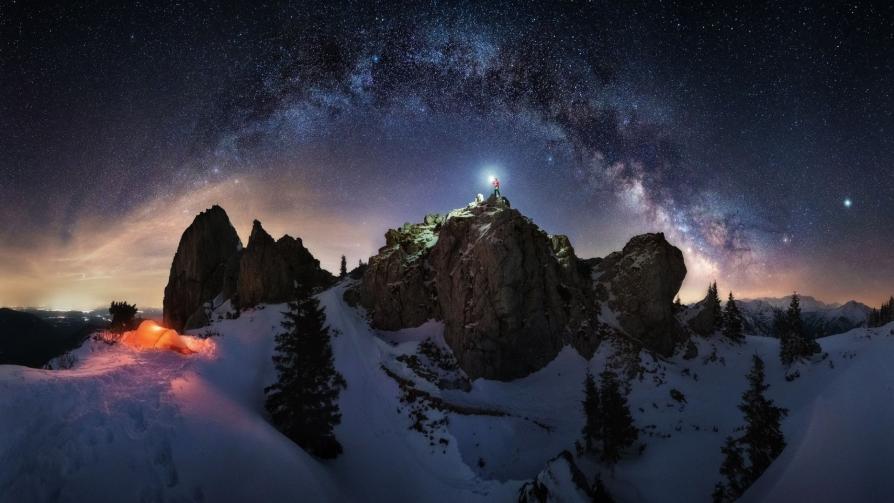Witnessing the Magic of Aurora Borealis: A Beginner's Guide to Northern Lights Photography
The Northern Lights, also known as Aurora Borealis, are a natural phenomenon that captivates the imagination with their ethereal beauty and vibrant colors. Capturing the allure of the aurora through photography can be a challenging yet rewarding experience. This beginner's guide provides essential knowledge and practical tips to help you capture stunning images of this celestial spectacle.

I. Understanding The Northern Lights
Scientific Explanation:
- The aurora is a result of the interaction between solar winds, the Earth's magnetic field, and the Earth's atmosphere.
- Solar winds, charged particles emitted from the sun, travel towards the Earth's magnetic field.
- The Earth's magnetic field guides these charged particles towards the poles, where they collide with atoms and molecules in the atmosphere, causing them to emit light.
Factors Affecting Visibility:
- Solar Activity: The intensity of the aurora is influenced by solar activity, with higher solar activity resulting in more frequent and vibrant auroras.
- Geomagnetic Storms: These storms, caused by disturbances in the Earth's magnetic field, can enhance the visibility of the aurora.
- Weather Conditions: Clear skies and dark conditions are ideal for aurora viewing and photography.
Best Time And Location:
- The best time to view and photograph the aurora is during the winter months, typically from September to April.
- Remote areas with dark skies and minimal light pollution offer the best opportunities for aurora photography.
- High-latitude regions, such as Alaska, Canada, Scandinavia, and Iceland, are known for their frequent and spectacular aurora displays.
II. Essential Photography Equipment
DSLR Or Mirrorless Camera:
- A DSLR or mirrorless camera with manual settings capability is essential for aurora photography.
- These cameras allow you to control aperture, shutter speed, ISO, and other settings to capture the best possible images.
Wide-Angle Lens:
- A wide-angle lens, such as a 10-20mm lens, is ideal for capturing the vastness of the aurora and the surrounding landscape.
- This type of lens allows you to fit more of the aurora into the frame, creating a dramatic and immersive composition.
Tripod:
- A sturdy tripod is essential for stability and sharp images, especially when using long exposure times.
- A tripod minimizes camera shake and ensures that your images are crisp and clear.
Remote Shutter Release Or Self-Timer:
- A remote shutter release or self-timer allows you to trigger the camera without touching it, minimizing camera shake.
- This is particularly useful for long exposure photography, where even slight camera movement can blur the image.
III. Camera Settings For Aurora Photography
Aperture:
- Use a wide aperture, such as f/8 or wider, to let in as much light as possible.
- A wide aperture increases the depth of field, ensuring that both the aurora and the foreground are in focus.
Shutter Speed:
- Use a long exposure time, typically between 15 and 30 seconds, to capture the movement and dynamic nature of the aurora.
- Longer exposure times allow more light to reach the sensor, resulting in brighter and more vibrant images.
ISO:
- Use a high ISO setting, such as ISO 1600-3200, to compensate for the low light conditions.
- Higher ISO settings increase the camera's sensitivity to light, allowing you to capture images in darker environments.
Focus:
- Use manual focus to ensure sharp images, especially in low-light conditions.
- Autofocus may struggle to find a focus point in the darkness, resulting in blurry images.
White Balance:
- Adjust the white balance to match the color temperature of the aurora.
- Tungsten or daylight white balance settings often work well for aurora photography.
IV. Composition And Techniques
Foreground Elements:
- Incorporate natural elements like trees, mountains, or lakes into your composition to add depth and context to your images.
- Foreground elements can help to create a sense of scale and provide a reference point for the viewer.
Rule Of Thirds:
- Position the aurora along the grid lines or at the intersection points of the rule of thirds for a balanced and visually appealing composition.
- This compositional technique helps to create a dynamic and engaging image.
Experiment With Shutter Speeds:
- Experiment with different shutter speeds to capture the dynamic movement of the aurora.
- Slower shutter speeds will create a more ethereal and flowing effect, while faster shutter speeds will freeze the movement of the aurora.
Use A Flashlight:
- Use a flashlight to illuminate the foreground and create a sense of depth in your images.
- This technique can help to bring out details in the foreground and add interest to your composition.
V. Post-Processing Tips
Raw Image Format:
- Shoot in RAW format to allow for more flexibility in post-processing.
- RAW files contain more image data than JPEG files, giving you more control over the final image.
Adjust Exposure, Contrast, And White Balance:
- Adjust the exposure, contrast, and white balance to enhance the colors and details of the aurora.
- Use editing software to fine-tune the image and bring out the best of the aurora's beauty.
Use Noise Reduction Tools:
- Use noise reduction tools to minimize image noise caused by high ISO settings.
- Noise reduction can help to create a cleaner and more polished image.
Experiment With Color Adjustments:
- Experiment with color adjustments to bring out the vibrant hues of the aurora.
- Adjust the saturation, hue, and temperature to create a unique and eye-catching image.
VI. Safety Considerations
- Dress appropriately for cold weather conditions, including warm layers, gloves, and a hat.
- Be aware of your surroundings and potential hazards in remote areas, such as wildlife and uneven terrain.
- Check local weather forecasts and aurora predictions before venturing out to ensure safe and successful aurora viewing and photography.
- Respect the environment and leave no trace of your presence by packing out all trash and avoiding disturbing the natural landscape.
VII. Conclusion
Capturing the beauty of the Northern Lights through photography is a rewarding experience that requires a combination of technical knowledge, creativity, and patience. By understanding the science behind the aurora, choosing the right equipment, and applying proper camera settings and composition techniques, you can create stunning images that capture the magic of this celestial phenomenon. Remember to prioritize safety and respect for the environment, and share your experiences with others to inspire awe and appreciation for the wonders of nature.
YesNo

Leave a Reply